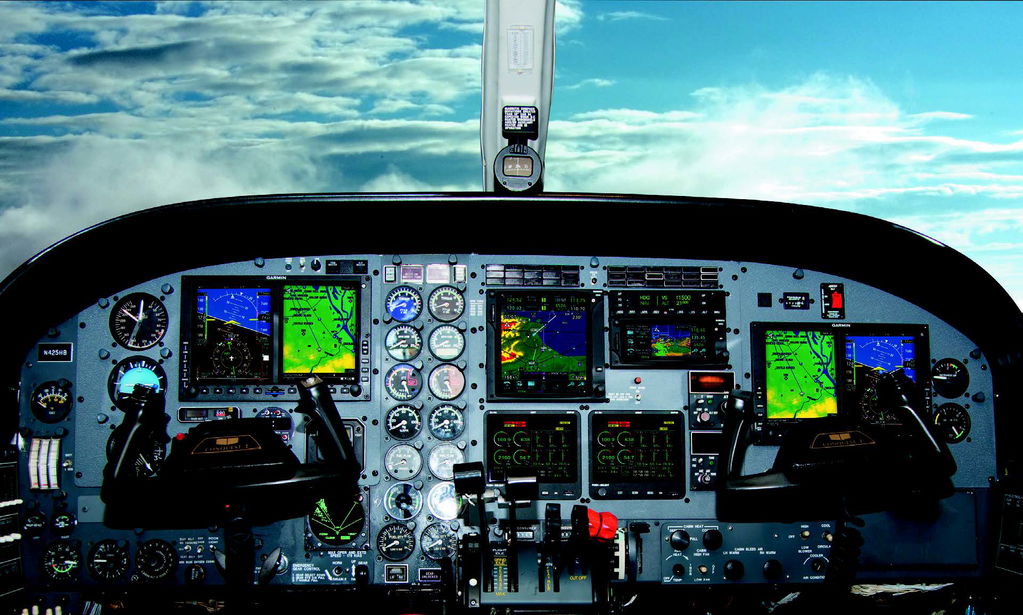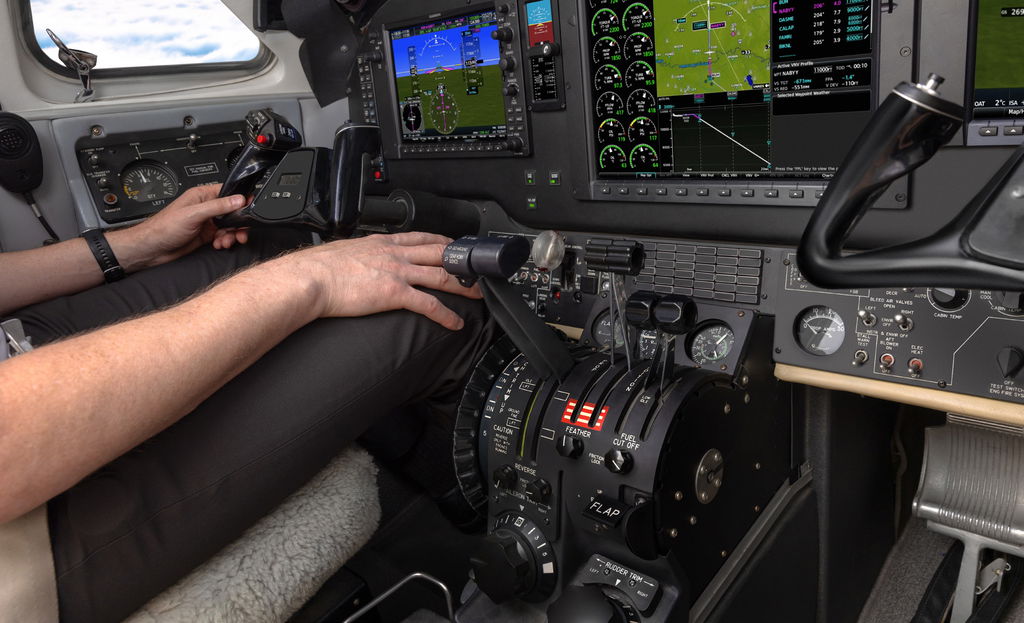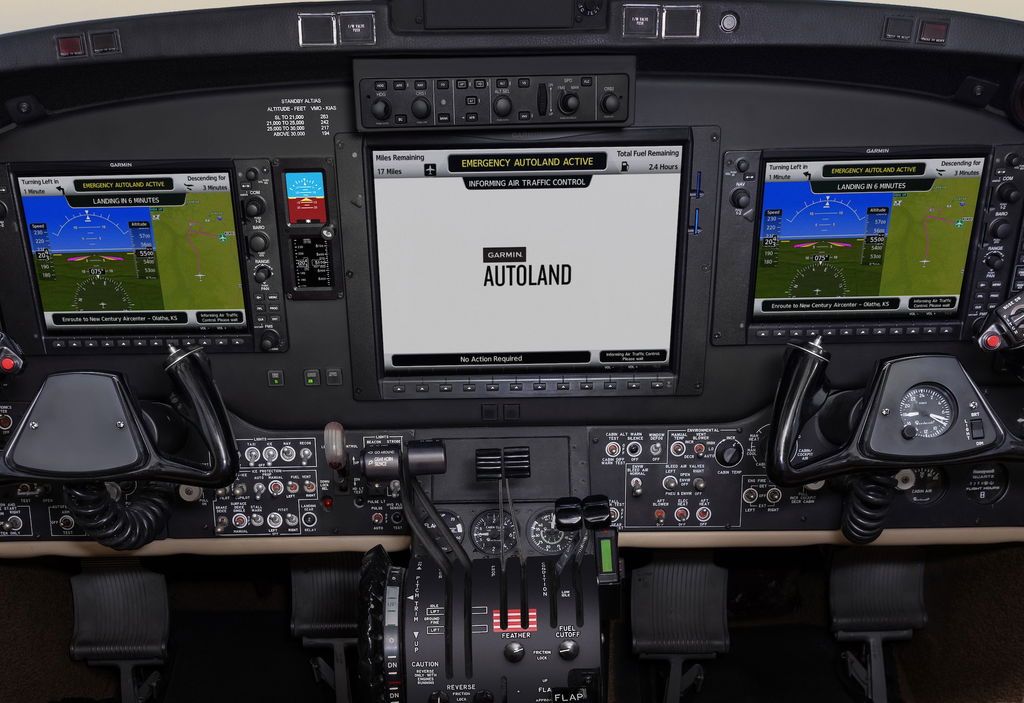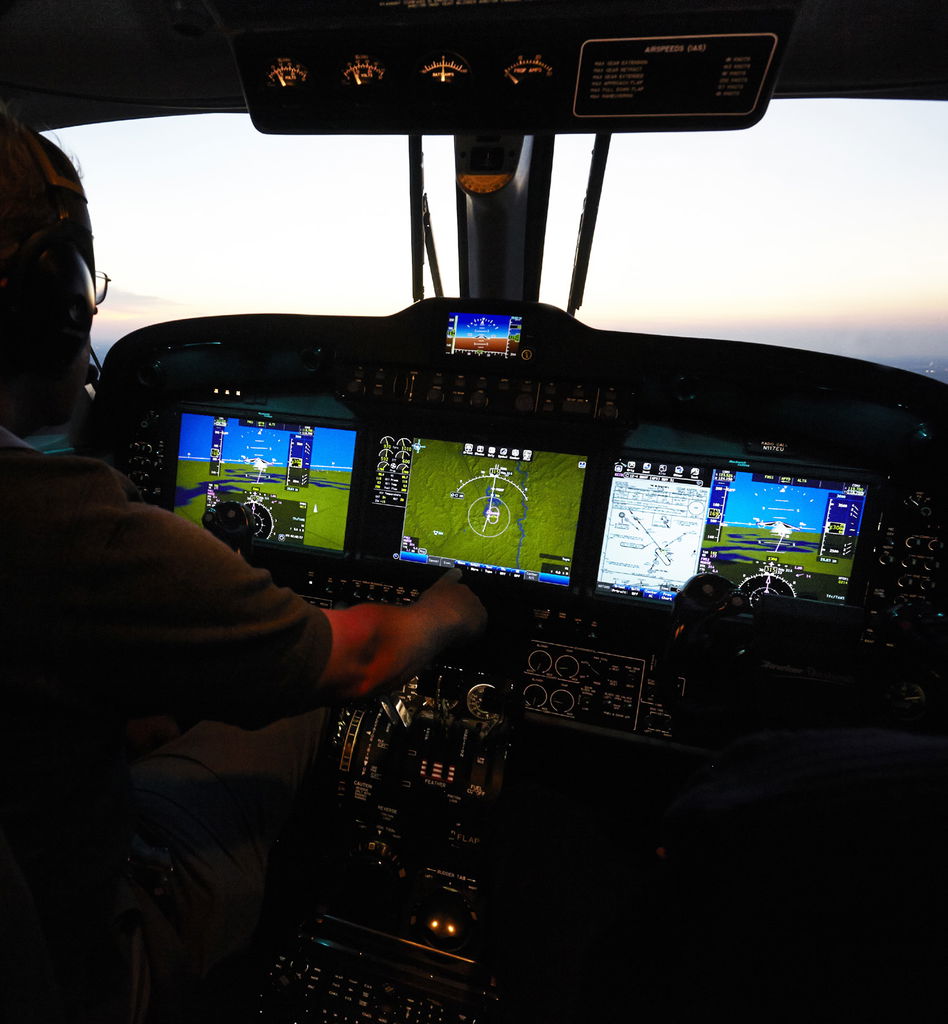For buyers stepping up into the world of turboprops and jets, a significant part of the transition might be learning an unfamiliar avionics suite. And for many aging aircraft that never had avionics upgrades, it means spending big on repairs and dealing with downtime, while sacrificing modern capabilities and automation that can increase workload.
This means buying the airplane right so there’s money—lots of it— left in the budget for major panel upgrades. But the choices for avionics in many aging turbines are generally more limited than for pistons because of fewer STC approvals. Still, the market for avionics systems for turbine airplanes is dominated by Garmin, which earns regulatory approval at impressive rates. From a capability standpoint, Garmin’s full-suite avionics that are now standard in many new jets and turboprops are trickling down to the aftermarket, and that’s bringing the capabilities of older turboprops and jets to a high level.
If you're not already a subscriber, what are you waiting for? Subscribe today to get the issue as soon as it is released in either Print or Digital formats.
Subscribe NowHere’s a look at common retrofit choices for popular turbine-powered airframes in hopes of helping the buying decision. The takeaway: It may make sense to buy an airplane that already has the avionics you want, but prepare to pay a hefty premium.
The Autopilot Dilemma
Part of the problem with full-suite avionics upgrades for entry-level turbines is the autopilot, or the lack of STC approval to retrofit new autopilots into older airframes. Availability aside, just as it is with the market’s lower end, autopilot retrofits for turbine aircraft mean major teardown and expense. Although many older turbines are in desperate need of reliable autopilots, making the work, expense, and long downtimes generally worth it.
As an example, while Garmin’s GFC 500 retrofit autopilot has become perhaps the most common in the piston world with a wide-reaching AML-STC, there isn’t a similar retrofit autopilot for turbines. However, Garmin is slowly adding to its turbine-category STC approval list with the good-performing, smart-servo-equipped digital GFC 600. This tech trickles down from the GFC 700 integrated autopilot found in Garmin’s G1000 and other integrated avionics suites.
It has features that offer sizable safety backstop, including Garmin’s ESP (electronic stability and protection) and return-to-level mode, smart rudder bias in twin-engine applications that stabilize the aircraft when an engine fails, plus flight director command bar presentation on Garmin flight displays, altitude preselect, and full approach coupling.
Popular models on Garmin’s G600 autopilot STC include the Cessna 208 and 208B Grand Caravan, Cessna 425 Conquest, plenty of King Air models, Pilatus PC-12/41/45/47, Piper 500TP Meridian and Malibu JetProp conversions, plus the Daher TBM 700 and TBM 850.
Most of these Garmin upgrades will go along with Garmin flight displays, including the G600 TXi and in some cases the G1000 and G5000, which have the embedded GFC flight control system. Garmin also has in progress other aircraft models in its certification program. In short, if you plan to install a retrofit Garmin glass suite in any turbine, ask the shop if the aircraft has STC approvals. Not all do.
Moreover, when deciding which aging jets it will pursue for an STC of this magnitude, Garmin also looks at obsolescence and the overall value of the aircraft. In the case of the G5000 retrofit as one example, owners will be making an investment that’s likely north of $600,000 and will require sizable amounts of downtime. But for the right jet, that could make sense—especially one that’s going through a complete refurbishment. Think like-new for a lot less money.
A final thought on autopilot upgrades is the Genesys Aerosystems S-TEC 3100 digital autopilot. It has compatibility with third-party flight displays, envelope protection, and full approach coupling. While the AML-STC list has been slow to evolve, it has become more available for common turboprops, including King Air models.
Garmin Full-Suite Upgrades
Garmin avionics for turbines start on the highest level with the newly introduced G3000 Prime suite, which isn’t available for retrofit, but the G5000 suite is. Garmin expanded on the successful G1000 King Air upgrade program (more on that in a minute) and targeted the Beechjet fleet with the retrofit of its big-screen G5000 integrated cockpit. Garmin expanded the G5000 STC project for workhorse Cessna jets, including the Cessna Citation XL/XLS models. Similar to the Beechjet (and the G1000 for King Airs), the G5000 for the Citation is a total transformation that essentially guts the airframe of the existing aging avionics, including the autopilot. It’s a huge project. When I visited the company’s Olathe, Kansas, engineering hangar to see a G5000 retrofit in progress, Garmin’s Dave Brown made a good point about these older turbine airframes needing a refresh.
“Basically, you’ve got a good airframe that operators love, but the thing is these airplanes came out in the mid-1990s and are equipped with older and less capable avionics, to include CRT displays. Now everything has gone to LCD,” Brown said.
With Garmin’s G5000 XL/XLS retrofit, operators essentially get all the avionics they would in a brand-new airplane. The G5000 STC yields the same flight deck that was standard in a new Citation X, Latitude, Longitude, Sovereign, and sister product (the Garmin G3000) in smaller Citation CJ3+ and M2 light jets.

Turbine panel upgrades mean long downtimes and big invoices, so it often makes sense to buy one already upgraded like this Conquest. [Courtesy: Garmin Aviaiton]
One of many advantages of upgrading the avionics in older turbines is the forward leap in ergonomics—which means lighter workload. Climbing into the G5000 XLS cockpit, it’s quickly apparent that Garmin worked hard to improve upon the ergonomics and overall layout of the flight deck. It starts with three 14-inch displays—pilot and copilot PFDs, plus an MFD. The screens (unlike the G1000, these are touchscreen) are so large in the Citation’s panel that the corners of the bezels are edged right to the end of the available structure. That’s a lot of screen area.
The other thing Garmin has done is moved the autopilot control panel to the area previously occupied by the CAS (crew alerting system) just below the glareshield. In the XLS, the old autopilot was down in the center pedestal and not the most convenient location. Most new jets and turboprops have the autopilot controller at the top of the panel for better ergos. Plus, in the XLS, that opens the center pedestal for the two-color touchscreen controllers that serve a variety of functions, including data entry for the G5000 suite. The backup instrument of choice in almost all of Garmin’s integrated avionics for turbines has become the Garmin GI 275—an instrument that has also gained popularity for primary equipment in piston applications.

The latest Garmin upgrade for select King Air models includes autothrottle and Emergency Autoland. [Courtesy: Garmin Aviaiton]
G1000 King Air: Autothrottle, Autoland
An early turbine makeover was the Garmin G1000 for the King Air, and to date over 900 airframes have been retrofitted. The King Air makes sense for this kind of upgrade because it’s the workhorse of the twin turboprop world. But Garmin surprised everyone a couple of years ago with the first retrofit Autoland system in a King Air 200. It’s no surprise that Garmin chose the King Air 200 (and soon the King Air 300, I’m told) as its first aftermarket retrofit.
King Airs have earned bragging rights as one of the best in class for dispatch reliability and mission flexibility, and many are owner flown. Garmin’s FMS-embedded Autothrottle isn’t new. It’s been flying in later-gen Cirrus Vision Jets, Daher TBMs, HondaJet Elite II, and now the Epic E1000 AX, where it’s proving to be a single-pilot workload reducer.
- READ MORE: Garmin Unveils G5000 PRIME Flight Deck
In the King Air interface, a major goal for Garmin was taming the dreaded engine failure that has put more than one King Air pilot in the National Transportation Safety Board accident reports. It has smart power management cues for securing a failed engine with the OEI ESP (one engine inoperative electronic stability and protection) feature. If an engine fails, the autopilot-based OEI ESP (standing by in the background and detecting the autopilot’s rudder boost has activated) will adjust the PFD’s roll limit indicators from 45 degrees inward to 10 degrees toward the failed engine and 40 degrees on the good engine. The pitch limits shrink from 20 to 10 degrees nose up and from 15 to 5 degrees nose down. OEI ESP is disabled with a push-button panel switch, where the system returns to the autopilot’s normal ESP mode.
There’s also automatic low airspeed protection when below VMCA, plus 15 knots indicated. Safety aside, Garmin’s King Air STC makes sense for the major Autothrottle and Autoland retrofit (commit to at least 300 hours of shop time). At press time there have been over 900 King Airs retrofitted with Garmin’s G1000 integrated avionics—the only aircraft model where an aftermarket G1000 installation is possible. Considering the teardown and complexity, that’s an impressive number and proof that owners see value in spending big to modernize their aging King Airs. Again, full-up refurbishment projects almost always include the G1000 for the King Air, and it really makes older models better, simpler airplanes, especially from a system’s standpoint where the AC inverter system comes out.
Currently, not all King Airs are eligible, including smaller 90-series planes. The AML-STC approval covers B200 King Airs equipped with at least Phase II G1000 NXi hardware, plus ones with PT6A-42/52/61 engines with four-blade propellers and hydraulic landing gear, which is a requirement for the Autoland option.
You can install Garmin’s Autothrottle without installing the Autoland, but Autoland won’t work without Autothrottle for obvious reasons. Garmin said that many customers will likely choose both for the ultimate safety enhancement and automation.

Given the value of the workhorse King Air 200, the huge investment that goes along with Garmin’s G1000 retrofit might be worth it. [Courtesy: Garmin Aviation]
Avidyne Atlas FMS
The Atlas system from Avidyne is unique because it provides a sizable—and relatively inexpensive—one-shot upgrade for old jets and turboprops that haven’t seen avionics upgrades in decades. It’s tough to believe, but in some cases, these old jets don’t even have WAAS GPS capability. That limits their operation—and their resale potential—because the avionics in many older jets aren’t supported and, if they are, it might not make sense to repair given their age and capability.
If you’re familiar with Avidyne’s IFD-series navigators, you’ll recognize the Atlas because that’s where the operating logic came from. But the hardware is sized for older jet panels, with a Dzus-mount chassis that fits the center pedestal area of jets that might already be equipped with ancient nav management systems that are long extinct. At 7.5 inches tall, 5.75 inches wide, and 10.61 inches deep, the system is designed to fit the space occupied by older FMS models. And compared to other avionics retrofit solutions, the Atlas can reduce installation effort because there could be less teardown and panel work. It also saves panel space and significantly reduces weight.
At the heart of Atlas is a GPS/SBAS flight management system that meets TSO-C146c for full SBAS/LPV approach guidance, plus it is an approved GPS position source for ADS-B. This GPS position source is one reason why ADS-B equipment for the turbine market was slow to evolve, and while the market has slowly caught up, there are plenty of jets that remain parked because they simply haven’t been upgraded yet. This is another solution.
Compared to some of the ancient avionics in the flight decks of some older jets, the Avidyne Atlas is worlds ahead. Like the IFD-series retrofit navigators, the Atlas has a modern feature set, with a hybrid control set.
Nearly anything you can accomplish with a touchscreen, you can also do with the unit’s hard controls—a feature that’s worked well for the appeal of Avidyne’s IFD navigators. But the real appeal of the Atlas is its ability to interface with a variety of third-party older avionics that are in older jets, with an I/O designed to integrate with existing EFIS, PFDs, CDIs, HSIs, remote sensors and autopilots.
Older jets might still have mechanical and analog flight instruments that may not work with some newer retrofit systems. For ADS-B support, the Atlas was designed to feed WAAS GPS position to a variety of Mode S transponders—an important part of upgrading older turbines. Consider that some used turbines are sourced from foreign countries where ADS-B requirements are nonexistent.

The Collins Pro Line Fusion integrated avionics suite in a King Air—another respected system within the King Air community. [Credit: Larry Anglisano]
Collins Pro Line Fusion
One turbine-caliber upgrade that doesn’t get a lot of attention is the Collins Pro Line Fusion. It’s a complete modernization that includes ADS-B mandate compliance, SBAS-capable GNSS, electronic charts, plus LPV approach capability—something that might be missing in aging aircraft. Fusion includes three 14.1-inch widescreen LCDs with modern graphics, configurable windows and touchscreen interfaces that are similar to the display configuration in newer King Air models delivered from the factory.
If you’ve ever flown a modern Rockwell Collins suite, you’ll recognize the airport dome and extended runway centerlines with mile markers that are intended to better orient the pilot from top of descent through final approach. The displays are touchscreen, plus there’s a QWERTY keypad and radio tuning knob console.
The aftermarket STC list is limited to Cessna Citation CJ1+, CJ2+ and CJ3 jets, plus the Beech King Air 200/300 series. There’s also the Rockwell Collins Pro Line 21 Modernization program, which steps the existing Collins suite in King Air, Premier 1/1A and Hawker 700/800XP/850XP models to a higher level.
A good source of information on Collins Fusion project is Elliott Aviation in Illinois, a busy shop that has certainly pushed out its share of Collins (and Garmin G1000) retrofits.
Forward Thinking
Forward thinking is what you need when pulling the trigger on an aging used turbine aircraft purchase. In addition to carefully considering the capabilities the aircraft has (or lacks) compared to what you’re used to in your piston model, consider the sizable upkeep that tags along with old analog avionics.
Systems like iron vertical gyros and complicated autopilots will be extremely costly to repair, plus replacement components are becoming harder for shops to source. Work closely with a trusted avionics pro before committing to any aircraft that has aging avionics and get a proposal for upgrading it so you can budget accordingly.
In the end, it could make sense to buy one that has the latest modern gear. The last thing you want to deal with is expensive avionics repairs and poor dispatch reliability after spending big for an aging turboprop or jet.
Used Market Realties
Like the used piston aircraft sales market, the used entry-level turboprop and jet landscape is the proverbial Wild West—with much higher stakes. That means making an accurate assessment of what you’ll need to spend (before closing the deal) to get the aircraft’s avionics up to a standard that you may be accustomed to after owning a well-equipped piston.
What many step-up buyers fail to realize is that these machines are far more complex to work on. Since they are pressurized, avionics installations may require expensive and time-consuming engineering approvals, just to name one aspect of the work.
I eyeballed the used market for some typical examples of what buyers might deal with and as expected, many aging turboprops have what’s called federated panels—which include a wide variety of avionics of different brands and vintages.
One example was a 1980 Piper Cheyenne II priced at $700,000. While it had a Garmin GTN 750 IFR navigator and newer Garmin weather radar, it still sported the original mechanical flight instruments, including King remote gyros and King KFC300 autopilot.
While Garmin has STC approval for G600 TXi flight displays in the Cheyenne, it doesn’t have approval for the GFC 600 autopilot (but at press time, it was close).
For the G600 TXi flight display upgrade with EIS engine instrumentation system and autopilot (once it’s available), you should realistically budget $200,000 when all is said and done. The flight displays can, however, work with analog KFC300, but it’s an old system. It’s a similar story with the Cessna Conquest series, where Garmin has STCs for the G600 TXi displays, EIS engine monitor and even the GFC 600 autopilot—a full Garmin suite.
Unless the aircraft is really priced right, I might suggest buying one that already has the avionics you want. A perfect example is the Daher TBM 700 series that were equipped with vintage King EFIS.
I found an early 2000 TBM700B that was already equipped with a full Garmin suite including G600 TXi, dual GTN navigators, GFC 600 autopilot, and GTX 345R ADS-B transponder. It makes for a clean, logical layout that should be familiar for pilots stepping out of modern pistons and in the end that should mean an easier transition compared to a plane with older, unfamiliar gear.
This feature first appeared in the June Ultimate Issue 959 of the FLYING print edition.





